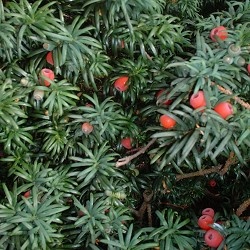Taxus






Taxus is a genus of small coniferous trees or shrubs known as yews. The genus is widely distributed across the Northern Hemisphere. It belongs to the family Taxaceae, which is distinct from many other conifers due to its members having a soft and fleshy fruit-like structure called an aril, which partially encloses the toxic seeds. Yews are notable for their long lifespan and are often found in gardens and parks due to their dense, dark green foliage and ease of pruning.
Description[edit]
Yews are evergreen trees with a dense growth habit. Their leaves are dark green, linear, and arranged in two flat rows on either side of the branch. The plants are dioecious, meaning individual trees are either male or female. Male yews produce small, spherical pollen cones, while female trees bear the distinctive red aril, which is a modified seed cone that becomes fleshy and bright red at maturity. Despite the aril being non-toxic and somewhat sweet, the seed contained within is highly poisonous.
Distribution and Habitat[edit]
Taxus species are found throughout the Northern Hemisphere, including North America, Europe, Africa, and Asia. They prefer moist, well-drained soils and can thrive in both full sun and partial shade. Yews are adaptable to various environmental conditions, which, combined with their resistance to disease and pests, makes them popular in cultivated landscapes.
Species[edit]
There are several species within the genus Taxus, including:
- Taxus baccata (European Yew)
- Taxus brevifolia (Pacific Yew)
- Taxus canadensis (Canadian Yew)
- Taxus cuspidata (Japanese Yew)
- Taxus floridana (Florida Yew)
- Taxus globosa (Mexican Yew)
Each species has its unique characteristics and habitat preferences, but all share the common features that define the yew genus.
Uses[edit]
Yews have been used for various purposes throughout history. The wood of yew trees is hard and durable, making it a preferred material for bow making in Europe and Asia. In landscaping, yews are popular for hedges and topiary due to their dense foliage and ability to withstand pruning.
Medicinally, compounds extracted from the bark of the Pacific Yew (Taxus brevifolia) are used to produce Paclitaxel, a drug used in the treatment of cancer. However, the toxic nature of yew seeds and foliage means that all parts of the plant, except the aril, are potentially lethal if ingested.
Conservation[edit]
While many yew species are common and not considered endangered, some, like the Florida Yew (Taxus floridana) and the Mexican Yew (Taxus globosa), face threats from habitat loss and overharvesting. Conservation efforts are in place to protect these species and their habitats.
Cultural Significance[edit]
Yews have held significant cultural and religious importance in various societies. In Europe, yews were often planted in churchyards, where they symbolized eternal life. The tree is also associated with various myths and legends, underscoring its deep-rooted presence in human culture.
Ad. Transform your life with W8MD's Budget GLP-1 injections from $75


W8MD offers a medical weight loss program to lose weight in Philadelphia. Our physician-supervised medical weight loss provides:
- Weight loss injections in NYC (generic and brand names):
- Zepbound / Mounjaro, Wegovy / Ozempic, Saxenda
- Most insurances accepted or discounted self-pay rates. We will obtain insurance prior authorizations if needed.
- Generic GLP1 weight loss injections from $75 for the starting dose.
- Also offer prescription weight loss medications including Phentermine, Qsymia, Diethylpropion, Contrave etc.
NYC weight loss doctor appointmentsNYC weight loss doctor appointments
Start your NYC weight loss journey today at our NYC medical weight loss and Philadelphia medical weight loss clinics.
- Call 718-946-5500 to lose weight in NYC or for medical weight loss in Philadelphia 215-676-2334.
- Tags:NYC medical weight loss, Philadelphia lose weight Zepbound NYC, Budget GLP1 weight loss injections, Wegovy Philadelphia, Wegovy NYC, Philadelphia medical weight loss, Brookly weight loss and Wegovy NYC
|
WikiMD's Wellness Encyclopedia |
| Let Food Be Thy Medicine Medicine Thy Food - Hippocrates |
Medical Disclaimer: WikiMD is not a substitute for professional medical advice. The information on WikiMD is provided as an information resource only, may be incorrect, outdated or misleading, and is not to be used or relied on for any diagnostic or treatment purposes. Please consult your health care provider before making any healthcare decisions or for guidance about a specific medical condition. WikiMD expressly disclaims responsibility, and shall have no liability, for any damages, loss, injury, or liability whatsoever suffered as a result of your reliance on the information contained in this site. By visiting this site you agree to the foregoing terms and conditions, which may from time to time be changed or supplemented by WikiMD. If you do not agree to the foregoing terms and conditions, you should not enter or use this site. See full disclaimer.
Credits:Most images are courtesy of Wikimedia commons, and templates, categories Wikipedia, licensed under CC BY SA or similar.
Translate this page: - East Asian
中文,
日本,
한국어,
South Asian
हिन्दी,
தமிழ்,
తెలుగు,
Urdu,
ಕನ್ನಡ,
Southeast Asian
Indonesian,
Vietnamese,
Thai,
မြန်မာဘာသာ,
বাংলা
European
español,
Deutsch,
français,
Greek,
português do Brasil,
polski,
română,
русский,
Nederlands,
norsk,
svenska,
suomi,
Italian
Middle Eastern & African
عربى,
Turkish,
Persian,
Hebrew,
Afrikaans,
isiZulu,
Kiswahili,
Other
Bulgarian,
Hungarian,
Czech,
Swedish,
മലയാളം,
मराठी,
ਪੰਜਾਬੀ,
ગુજરાતી,
Portuguese,
Ukrainian
